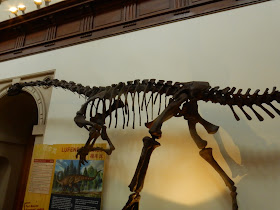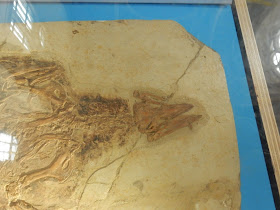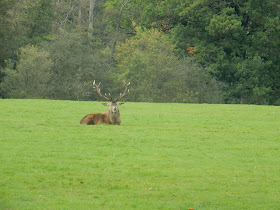Unfortunately for anyone who hasn't visited this exhibit at the time of this posting, it is now closed. As one might expect, I've wanted to visit the Dinosaurs of China ever since I first heard of its existence, but I put my trip off until the very last minute because I'd learned from Google Maps that it would take a grueling series of transfers between different train lines for me to reach the exhibition by public transport. As such, I'd been banking on the possibility of someone driving me there instead. Though some options were discussed, none ultimately panned out, so during the last week that the exhibit was open, I decided to bite the bullet and book the train to Nottingham. It was a fairly exhausting journey, but it hadn't been nearly as convoluted as Google Maps had led me to believe. Lesson learned about being overly trusting of Google, I suppose.
The long trip was more than worth it though. Visitors were first greeted by this giant Mamenchisaurus.
Nearby was a smaller and slightly older sauropodomorph, Lufengosaurus. The pronated hands on the bipedal dinosaur mounts were a recurring problem at this exhibit and just a little cringe-inducing, but hardly enough to tarnish all the greatness on display.
Greatness such as this juvenile Pinacosaurus specimen!
Though there was no sign of the famed feathered dinosaur specimens just yet, a Guanlong was mounted next to an ostrich here for comparison.
This Sinraptor mount was quite impressive, mounted as though it were prowling around.
Perhaps just as notable as the displays themselves was how well the temporary exhibition was integrated into the Wollaton Hall's existing galleries. Visitors were directed through a hall filled with the museum's taxidermied birds, which were magnificent displays in their own right. Given that my research focuses on strisorian birds at the moment, I was particularly drawn to this Eurasian nightjar.
Slotted in between the birds was this mount that's apparently supposed to be Oviraptor (but I wonder whether it was based on any other oviraptorids), posed over a model of its nest.
There was also a very faithful-looking 3D print of the Mei holotype!
The real stars of the show feature in the final hall, starting with this original specimen of Sinosauropteryx!
Sinosauropteryx was both the first non-avian dinosaur found with preserved feathers as well as the first Mesozoic dinosaur to have had its plumage color deciphered. Can you spot the tail stripes?
A mount of the giant oviraptorosaur Gigantoraptor formed the centerpiece of the hall, though the space and lighting made it difficult to capture good photos of it.
Another display that proved challenging to photograph was this cast of Linheraptor, due to barriers that kept visitors a good distance away.
A nice cast of the scansoriopterygid Epidexipteryx, known for its four very elongate tail feathers.
The original holotype of Caudipteryx dongi! Note the wing feathers and gastroliths.
What might this be? This is the infamous "Archaeoraptor" hoax, a chimera created by combining specimens of several different feathered dinosaurs into one.
"Archaeoraptor" was exhibited alongside more complete specimens of its component taxa. Pictured here is possibly the highlight of the entire exhibition: an original specimen of the flying dromaeosaurid Microraptor. Though iconic, this specimen is not, in fact, the holotype of the genus Microraptor (which is far less impressive), but it is the holotype of the species Microraptor gui (which may or may not end up being the same as the type species M. zhaoianus). Microraptor contributed the tail of the "Archaeoraptor" hoax.
"Archaeoraptor"'s better half is the Cretaceous euornithine Yanornis, which contributed its head and upper body.
Yanornis had a foldable tail fan like modern birds, a feature not present in non-euornithine theropods (contrary to many popular depictions).
A cast of the holotype of Sinornithosaurus, a close relative of Microraptor.
A cast of the holotype of the feathered tyrannosauroid Dilong. (This specimen did not preserve feathers.)
A cast of the holotype of the enantiornithine Protopteryx.
An original specimen of Confuciusornis.
The final section of the fossil exhibit drew attention to other Mesozoic archosaurs that independently evolved flight from birds and their close kin. Representing pterosaurs is this cast of Wukongopterus.
This 3D print of the membrane-winged theropod Yi was somewhat subpar, preserving little of the original detail. However, as with the pronated hands on the mounts, this was but a minor imperfection compared to the quality of the exhibit as a whole.
Back in the museum's permanent exhibitions, visitors were reminded that the taxidermied birds represented extant dinosaurs. What was more striking to me though was the bleak narrative that accompanies one diorama.
Wollaton Hall is situated within a surprisingly large park in which wild deer roam. This red deer stag appeared to be content sitting out in the grass all day. Not pictured is the astonishingly large number of people who were getting stupidly close to it.
The abundant greenery and large lake at the park provided some decent birding opportunities after visiting the once-in-a-lifetime exhibit!





































No comments:
Post a Comment